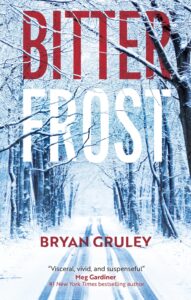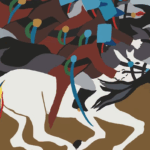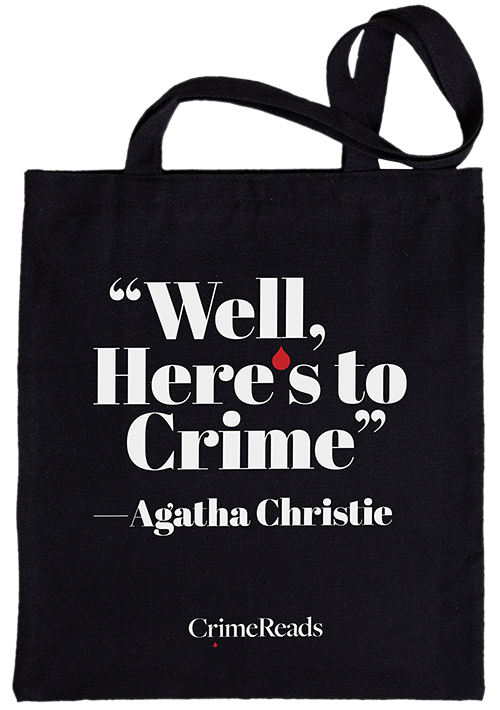Twenty-one years ago, National Hockey League forward Todd Bertuzzi got into an on-ice altercation with an opponent named Steve Moore. The encounter grew exceptionally violent. Moore suffered injuries that ended his NHL career. Bertuzzi went through civil and criminal litigation hell, but eventually resumed what turned out to be a decent hockey career.
As a hockey player myself, I found this outcome upsetting. Why, I thought, shouldn’t Bertuzzi be suspended from the game for as long as Moore was unable to play? It seemed only fair. Over time, I calmed down, realizing I knew little about what actually transpired between those competitors before and during their fight. But another, bigger question lingered: How do you cope with the knowledge that you may have ruined a life?
My rumination inspired me to create the protagonist Jimmy Baker in my sixth novel, Bitterfrost. Thirteen years before the start of Bitterfrost, Jimmy almost killed an opponent in a hockey fight, then quit the game forever. Now he’s the Zamboni driver for an elite amateur team in his hometown of Bitterfrost in northern lower Michigan. His violent past rears up in the present when he’s accused of a brutal double murder.
All but one of my novels borrow from occurrences in the so-called real world. But I don’t feel they’ve been “ripped from the headlines,” as goes that tired pejorative beloved by agents and editors. Really, what novel doesn’t build on stuff that actually happens: war and revolution, romance and rupture, murder and rape, triumph and tragedy, birth and death. Yet there is a difference between dramatizing current or past events as a biographer or historian might, and making them into something more, perhaps radically so, than their who, what, where, when, and how. It’s less about the replication of simple facts than the divining of universal truths. The saying goes that truth is stranger than fiction, but I would counter that fiction should strive to be richer than truth.
At a book event years ago, I asked Dennis Lehane about the research he’d done on Babe Ruth and Lou Gehrig to prepare for writing the delicious prologue in his novel, The Given Day. He said he hadn’t done much. He felt he already knew enough about the Yankee legends from a lifetime following baseball to portray them accurately enough. “I really just wanted to get the emotional truth right,” he told me. Only after drafting the scene did he go back and do some fact-checking; he learned that Ruth at the time of the tale he invented wasn’t yet the beer-bellied slugger of Murderers Row, but a slim, handsome young man.
Lehane’s phrase—the emotional truth—stuck with me. My third novel, The Skeleton Box, was inspired by the story of the 1907 murder of a nun. I first read about it in an anthology of decades-old Michigan murders I bought at a beer store for five bucks. After the nun was bludgeoned to death, the killer buried the remains beneath the church. Years later, two men were ordered to dig her up, and I felt a thrilling chill (or was it a chilling thrill?) at the idea of these guys with shovels and lanterns unearthing a shadowy box of bones.
Man, I had to write about that.
A few years passed before I tried. By then, Michigan author Mardi Link had published a superb non-fiction book, Isadore’s Secret, about the murder of Sister Mary Janina at Holy Rosary Catholic Church in Cedar, Michigan. I bought the book and started it, while reminding myself of Lehane’s words. I decided that knowing too much about Sister Mary Janina and the sensational trial of her killer (covered by The New York Times) could chain me to facts and details that might not meld with the tale I wanted to tell. I coveted the spooky dread evoked by that skeleton box, but I didn’t want the historical tissue attached to it. In my novel, a nun named Cordelia is murdered but the circumstances, timing, and motives—essentially everything that matters—are different. I had to forget the real story to tell my real story.
When I started Bitterfrost, I read a little about the 2004 Bertuzzi-Moore confrontation, but not much. There was plenty available; heck, I could have contacted Bertuzzi to ask a few questions, the kind of thing I did for forty-one years as a newspaper and magazine journalist. But I wanted Jimmy Baker to inhabit his own emotional reality. Jimmy doesn’t resume his career; he walks away from it. Along with his livelihood, he surrenders his marriage and becomes estranged from his daughter. He moves back to his hometown and takes a job that puts him close to hockey but not in it. Eventually, his past bears down on his present when he’s accused of beating to death two younger men he encountered in a Bitterfrost tavern.
Throughout his travails, Jimmy embraces a mantra that, to me, hints at how a person can deal with his or her most fateful mistakes. “Every day,” Jimmy tells himself, “is a penance.” I have no idea what Todd Bertuzzi would think of that, but it doesn’t really matter. Jimmy is not Bertuzzi, and Bitterfrost tells an entirely different story—for what I hope is the best.
***














